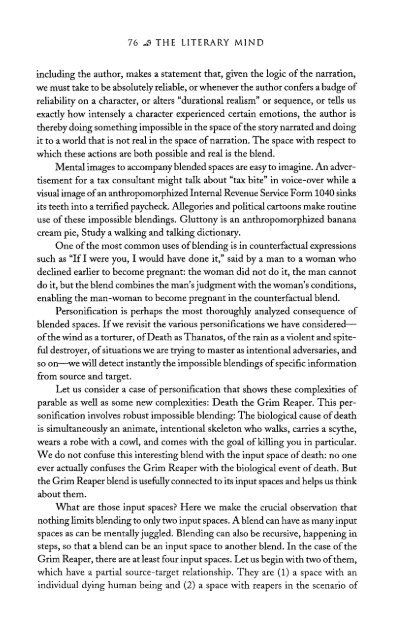The Literary Mind.pdf
The Literary Mind.pdf
The Literary Mind.pdf
You also want an ePaper? Increase the reach of your titles
YUMPU automatically turns print PDFs into web optimized ePapers that Google loves.
76 THE LITERARY MIND<br />
including the author, makes a statement that, given the logic of the narration,<br />
we must take to be absolutely reliable, or whenever the author confers a badge of<br />
reliability on a character, or alters "durational realism" or sequence, or tells us<br />
exactly how intensely a character experienced certain emotions, the author is<br />
thereby doing something impossible in the space of the story narrated and doing<br />
it to a world that is not real in the space of narration. <strong>The</strong> space with respect to<br />
which these actions are both possible and real is the blend.<br />
Mental images to accompany blended spaces are easy to imagine. An advertisement<br />
for a tax consultant might talk about "tax bite" in voice-over while a<br />
visual image of an anthropomorphized Internal Revenue Service Form 1040 sinks<br />
its teeth into a terrified paycheck. Allegories and political cartoons make routine<br />
use of these impossible blendings. Gluttony is an anthropomorphized banana<br />
cream pie, Study a walking and talking dictionary.<br />
One of the most common uses of blending is in counterfactual expressions<br />
such as "If I were you, I would have done it," said by a man to a woman who<br />
declined earlier to become pregnant: the woman did not do it, the man cannot<br />
do it, but the blend combines the man's judgment with the woman's conditions,<br />
enabling the man-woman to become pregnant in the counterfactual blend.<br />
Personification is perhaps the most thoroughly analyzed consequence of<br />
blended spaces. If we revisit the various personifications we have considered—<br />
of the wind as a torturer, of Death as Thanatos, of the rain as a violent and spiteful<br />
destroyer, of situations we are trying to master as intentional adversaries, and<br />
so on—we will detect instantly the impossible blendings of specific information<br />
from source and target.<br />
Let us consider a case of personification that shows these complexities of<br />
parable as well as some new complexities: Death the Grim Reaper. This personification<br />
involves robust impossible blending: <strong>The</strong> biological cause of death<br />
is simultaneously an animate, intentional skeleton who walks, carries a scythe,<br />
wears a robe with a cowl, and comes with the goal of killing you in particular.<br />
We do not confuse this interesting blend with the input space of death: no one<br />
ever actually confuses the Grim Reaper with the biological event of death. But<br />
the Grim Reaper blend is usefully connected to its input spaces and helps us think<br />
about them.<br />
What are those input spaces? Here we make the crucial observation that<br />
nothing limits blending to only two input spaces. A blend can have as many input<br />
spaces as can be mentally juggled. Blending can also be recursive, happening in<br />
steps, so that a blend can be an input space to another blend. In the case of the<br />
Grim Reaper, there are at least four input spaces. Let us begin with two of them,<br />
which have a partial source-target relationship. <strong>The</strong>y are (1) a space with an<br />
individual dying human being and (2) a space with reapers in the scenario of















